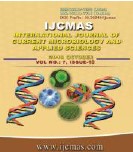


 National Academy of Agricultural Sciences (NAAS)
National Academy of Agricultural Sciences (NAAS)

|
PRINT ISSN : 2319-7692
Online ISSN : 2319-7706 Issues : 12 per year Publisher : Excellent Publishers Email : editorijcmas@gmail.com / submit@ijcmas.com Editor-in-chief: Dr.M.Prakash Index Copernicus ICV 2018: 95.39 NAAS RATING 2020: 5.38 |
In tropical countries rice has been identified as one of the crops that are particularly susceptible to the negative impacts of pesticide use. In addition to the physicochemical nature of the pesticide, tropical climatic conditions and agricultural practices play important roles in determining the fate and distribution of pesticides in the tropical paddy field ecosystem. The assessment of toxicological effects of pesticides in the tropical paddy has been evaluated through seed germination percentage, vegetative parameters and chlorophyll content. The seedlings are the crucial stage of the plant, so, the experimental study evaluated 14 days old seedling’s vegetative growth parameters and chlorophyll content and percentage of seed germination influenced by different biocides (neem oil, carbosulfan and Oxadiargyl). The experimental results found that all concentrations of (0.5, 1.5, 2.0, 2.5, 3.0, 3.5, 4.0, 4.5, 5.0 ml/l) neem oil, carbosulfan and oxadiargyl decreased the percentage of seed germination, vegetative parameters and chlorophyll content. Out of these three biocides, neem oil was found less toxic towards the test cultivar. Effective training of the paddy farmer has been identified as the key to successful implementation of integrated pest management strategies for more productivity.
 |
 |
 |
 |
 |